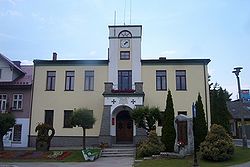Piwniczna-Zdrój
| Piwniczna-Zdrój | ||
|---|---|---|

Town Hall
|
||
|
||
| Coordinates: 49°26′7″N 20°42′41″E / 49.43528°N 20.71139°E | ||
| Country |
|
|
| Voivodeship | Lesser Poland | |
| County | Nowy Sącz | |
| Gmina | Piwniczna-Zdrój | |
| Area | ||
| • Total | 126.7 km2 (48.9 sq mi) | |
| Elevation | 562 m (1,844 ft) | |
| Population (2012) | ||
| • Total | 10 315 | |
| Postal code | 33-350 | |
| Website | http://www.piwniczna.pl | |
Piwniczna-Zdrój [pʲivˈɲit͡ʂna ˈzdrui̯] (until 1999 Piwniczna, Ukrainian: Північна, Pivnichna) is a town in Nowy Sącz County, Lesser Poland Voivodeship, Poland, near the border with Slovakia. Piwniczna-Zdrój is the name of both the town and its administrative district called a gmina in Polish, namely the Gmina Piwniczna-Zdrój.
Piwniczna-Zdrój is a popular tourist destination in Beskid Sądecki, part of the Western Carpathians mountain range of southern Poland featuring a protected area called the Poprad Landscape Park with its picturesque Poprad River Gorge.
The total area of Piwniczna-Zdrój county is 3,830 ha (30.2% of which lies within the commune), while the rural area is 8,816 ha (69.8% of the commune). The municipal area consists of six villages: Młodów, Głębokie, Kokuszka, Łomnica-Zdrój, Wierchomla, and Zubrzyk.
In Poland, the word miasto is often used for both a town and a city. Miasto is a category applied on the basis of the administrative decision of the central government. The nearest English equivalent of Piwniczna-Zdrój would therefore be a town inside a county (gmina or powiat) that has a city charter. The equivalent title of County or Municipality however belongs to Nowy Sącz. The best matching organizational structure outside Poland would be a regional county municipality (RCM), which replaced established County designations in some countries and added layers of census divisions at its lower levels.
In the Middle Ages, the settlement of Piwniczna was located along a busy merchant trail, which joined Poland with Hungarian-ruled Slovakia (see Upper Hungary). To protect the route and increase tax revenue, on July 1, 1348 in Kraków, King Kazimierz Wielki granted a privillege to a wealthy resident of Nowy Sacz, Hanko, upon which a brand new town was to be established in an oxbow of the Poprad river. The town was granted Magdeburg rights, and was named after its location, as the Poprad oxbow was called Piwniczna Szyja.
...
Wikipedia


